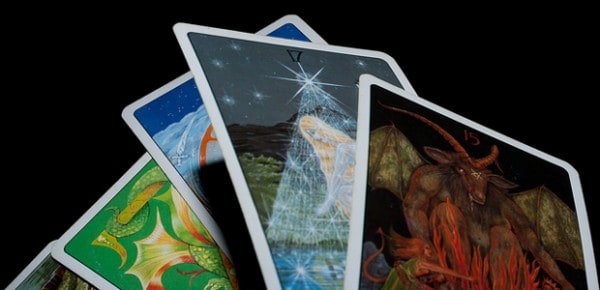 Recently I posted a list of my top five foundational books on tarot – books that give a solid grounding in tarot’s history and practical use.
Recently I posted a list of my top five foundational books on tarot – books that give a solid grounding in tarot’s history and practical use.
Ankh-f-n-khonsu commented:
I’m no tarotist scholar, and I found Decker’s article in Gnosis (#46, Winter 1998) convincing and enlightening. However, I was left unconvinced that there was no connection to esoteric Egyptian tradition. Tony Bushby…suggests that 22 Hebrew characters were ‘occulted’ in the Egyptian Book of Thoth/God, and that ‘tarot’ is a plural form of Torah. […]
In tarot’s fairly well documented history (letters, accounting ledgers, early examples of tarot cards and “regular” playing cards, etc.), there is absolutely no suggestion whatsoever that tarot cards were intended for use as anything other than an innovating card game. Serious tarot practitioners know this, it’s the occultists who resist reading anything in depth outside their genre – and I say this as an occultist myself! (Probably because occultists have invested so much in the mystification of tarot they figure it’d be a shame to stop now.)
That doesn’t mean that its repurposing as an occult tool is valueless; on the contrary, thanks to Lévi’s “modern” popularization in particular, the tarot has become a nexus of occult symbolism. The tarot’s medieval Italian symbolism has been reinterpreted with everything from kabbalah, the Hebrew alphabet, the tetragrammaton, astrology, the elements, etc. being mapped on to its structure.
The tarot has become a central tool and symbol set for occultists. That it wasn’t so historically comes as a bit of a downer, but it can work – even if it is, quite often, an awkward fit.
The ancient Egyptians didn’t have paper, and the story of tablets is plainly absurd. The first European paper wasn’t made until 1151 in Spain, and it’s another two hundred years until we hear of playing cards mentioned in Europe. While there are decks of Mamluk playing cards extant dating from the twelfth or thirteenth century, the first mention of playing cards in Europe come from Bern, Switzerland in 1367. It’s not until 1442 that trinofi (tarot cards) are mentioned. Some scholars allow that it’s likely the cards were invented some years before being written about, and suggest an approximate date of 1420 for their invention – at the earliest.
The etymological origins of the word “tarot” are fairly straightforward.
Tarot comes from the Italian word trionfi, used in the fifteenth century to describe the twenty-two trump cards. Tarocchi gained currency in the early sixteenth century, first representing to the twenty-two trumps, and later to the complete seventy-eight card deck. The word tarocchi and tarocco are often used interchangeably, though tarocchi is actually the plural of tarocco. The French derivative tarot has come into widespread usage in English, though the English term “trump” is derived from the Latin triumphi.
Thanks for your question, Ankh-f-n-khonsu!
First published on Plutonica.net 4 April 2008.
Image credit: Derek Gavey








